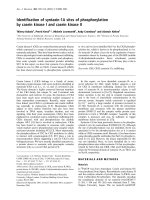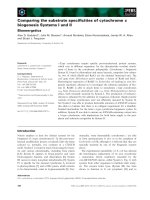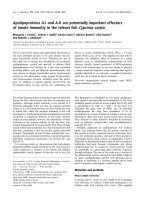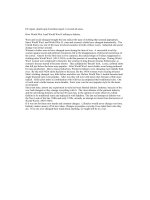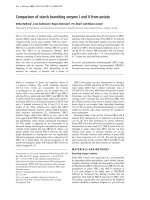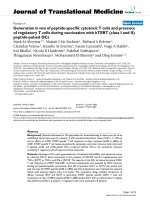Serge lang cyclotomic fields i and II (1990) 978 1 4612 0987 4
Bạn đang xem bản rút gọn của tài liệu. Xem và tải ngay bản đầy đủ của tài liệu tại đây (23.33 MB, 449 trang )
Graduate Texts in Mathematics
121
Editorial Board
J.H. Ewing
F.W. Gehring
P.R. Halmos
www.pdfgrip.com
Graduate Texts in Mathematics
2
3
4
5
6
7
8
9
10
II
12
13
14
15
16
17
18
19
20
21
22
23
24
25
26
27
28
29
30
31
32
33
34
35
36
37
38
39
40
41
42
43
44
45
46
47
TAKEUTIIZARING. Introduction to Axiomatic Set Theory. 2nd ed.
OXTOBY. Measure and Category. 2nd ed.
SCHAEFFER. Topological Vector Spaces.
HILTON/STAMMBACH. A Course in Homological Algebra.
MAC LANE. Categories for the Working Mathematician.
HUGHES/PIPER. Projective Planes.
SERRE. A Course in Arithmetic.
T AKEUTIIZARING. Axiomatic Set Theory.
HUMPHREYS. Introduction to Lie Algebras and Representation Theory.
COHEN. A Course in Simple Homotopy Theory.
CONWAY. Functions of One Complex Variable. 2nd ed.
BEALS. Advanced Mathematical Analysis.
ANDERSON/FuLLER. Rings and Categories of Modules.
GOLUBITSKy/GUILLEMIN. Stable Mappings and Their Singularities.
BERBERIAN. Lectures in Functional Analysis and Operator Theory.
WINTER. The Structure of Fields.
ROSENBLATT. Random Processes. 2nd ed.
HALMos. Measure Theory.
HALMos. A Hilbert Space Problem Book. 2nd ed., revised.
HUSEMOLLER. Fibre Bundles. 2nd ed.
HUMPHREYS. Linear Algebraic Groups.
BARNES/MACK. An Algebraic Introduction to Mathematical Logic.
GREUB. Linear Algebra. 4th ed.
HOLMES. Geometric Functional Analysis and its Applications.
HEWITT/STROMBERG. Real and Abstract Analysis.
MANES. Algebraic Theories.
KELLEY. General Topology.
ZARISKIISAMUEL. Commutative Algebra. Vol. I.
ZARISKIISAMUEL. Commutative Algebra. Vol. II.
JACOBSON. Lectures in Abstract Algebra I: Basic Concepts.
JACOBSON. Lectures in Abstract Algebra II: Linear Algebra.
JACOBSON. Lectures in Abstract Algebra III: Theory of Fields and Galois Theory.
HIRSCH. Differential Topology.
SPITZER. Principles of Random Walk. 2nd ed.
WERMER. Banach Algebras and Several Complex Variables. 2nd ed.
KELLEy/NAMIOKA et al. Linear Topological Spaces.
MONK. Mathematical Logic.
GRAUERT/FRITZSCHE. Several Complex Variables.
ARVESON. An Invitation to C*-Algebras.
KEMENy/SNELL/KNAPP. Denumerable Markov Chains. 2nd ed.
APOSTOL. Modular Functions and Dirichlet Series in Number Theory. 2nd ed.
SERRE. Linear Representations of Finite Groups.
GILLMAN/JERISON. Rings of Continuous Functions.
KENDIG. Elementary Algebraic Geometry.
LOEVE. Probability Theory I. 4th ed.
LOEVE. Probability Theory II. 4th ed.
MOISE. Geometric Topology in Dimensions 2 and 3.
www.pdfgrip.com
Serge Lang
Cyclotomic Fields I and II
Combined Second Edition
With an Appendix by Karl Rubin
Springer Science+Business Media, LLC
www.pdfgrip.com
Serge Lang
Department of Mathematics
Yale University
New Haven, CT 06520
U.S.A.
Editorial Board
J.H. Ewing
Department of
Mathematics
Indiana University
B1oomington, IN 47405
U.SA
F.W. Gehring
Department of
Mathematics
University of Michigan
Ann Arbor, MI 48109
U.SA
P.R. Halmos
Department of
Mathematics
Santa Clara University
Santa Clara, CA 95053
U.SA
Mathematical Subject Classifications (1980): 12A35, 12B30, 12C20, 14G20
Library of Congress Cataloging-in-Publication Data
Lang,Serge, 1927Cyc\otomic fields l and II (Combined Second Edition)/Serge Lang
p. cm. -- (Graduate texts in mathematics; 121)
Bibliography: p.
Includes index.
ISBN 0-387-96671-4
1. Fields, Aigebraic. 2. Cyclotomy.
QA247.L33 1990
512'.3--dc19
I. Title. II. Series
87-35616
This book is a combined edition of the books previously published as Cyclotomic Fields and
Cyclotomic Fields II, by Springer Science+Business Media, LLC, in 1978 and 1980, respectively.
It contains an additional appendix by Karl Rubin.
©
1990 by Springer Science+Business Media New York
Originally published by Springer-VerlagNew York Inc. in 1990
Softcover reprint of the hardcover 2nd edition 1990
AII rights reserved. This work may not be translated or copied in whole or in part without the written
permission ofthe publisher (Springer Science+Business Media. LLC). except for brief excerpts in
connection with reviews or scholarly analysis. Use in connection with any form of information storage and retrieval. electronic adaptation. computer software. or by similar or dissimilar methodology
now known or hereafter developed is forbidden.
The use of general descriptive names, trade names, trademarks, etc. in this publication, even if
the former are not especially identified, is not to be taken as a sign that such names, as understood
by the Trade Marks and Merchandise Marks Act, may accordingly be used freely by anyone.
9 8 7 6 54 3 2 1
ISBN 978-1-4612-6972-4
ISBN 978-1-4612-0987-4 (eBook)
DOI 10.1007/978-1-4612-0987-4
www.pdfgrip.com
Contents
Notation
xi
Introduction
xiii
CHAPTER 1
Character Sums
1.
2.
3.
4.
5.
6.
1
Character Sums over Finite Fields
Stickel berger's Theorem
Relations in the Ideal Classes
Jacobi Sums as Hecke Characters
Gauss Sums over Extension Fields
Application to the Fermat Curve
1
6
14
16
20
22
CHAPTER 2
Stickelberger Ideals and Bernoulli Distributions
26
1.
2.
3.
4.
5.
6.
7.
8.
9.
10.
27
32
43
48
The Index of the First Stickel berger Ideal
Bernoulli Numbers
Integral Stickel berger Ideals
General Comments on Indices
The Index for k Even
The Index for k Odd
Twistings and Stickel berger Ideals
Stickel berger Elements as Distributions
Universal Distributions
The Davenport-Hasse Distribution
Appendix. Distributions
49
50
51
53
57
61
65
v
www.pdfgrip.com
Contents
CHAPTER 3
Complex Analytic Class Number Formulas
69
1. Gauss Sums on Z/mZ
2. Primitive L-series
3. Decomposition of L-series
4. The (± 1)-eigenspaces
5. Cyclotomic Units
6. The Dedekind Determinant
7. Bounds for Class Numbers
72
75
81
84
89
91
69
CHAPTER 4
The p-adic L-function
94
1.
2.
3.
101
4.
5.
6.
Measures and Power Series
Operations on Measures and Power Series
The Mellin Transform and p-adic L-function
Appendix. The p-adic Logarithm
The p-adic Regulator
The Formal Leopoldt Transform
The p-adic Leopoldt Transform
95
105
III
112
115
117
CHAPTER 5
Iwasawa Theory and Ideal Class Groups
1.
2.
3.
4.
5.
6.
The Iwasawa Algebra
Weierstrass Preparation Theorem
Modules over Zp[[X]]
Zp-extensions and Ideal Class Groups
The Maximal p-abelian p-ramified Extension
The Galois Group as Module over the Iwasawa Algebra
123
124
129
131
137
143
145
CHAPTER 6
Kummer Theory over Cyclotomic Zp-extensions
1.
2.
3.
4.
The Cyclotomic Zp-extension
The Maximal p-abelian p-ramified Extension of the Cyclotomic
Zp-extension
Cyclotomic Units as a Universal Distribution
The Iwasawa-Leopoldt Theorem and the Kummer-Vandiver
Conjecture
148
148
152
157
160
CHAPTER 7
Iwasawa Theory of Local Units
1.
2.
3.
4.
5.
The Kummer-Takagi Exponents
Projective Limit of the Unit Groups
A Basis for U(x) over A
The Coates-Wiles Homomorphism
The Closure of the Cyclotomic Units
vi
www.pdfgrip.com
166
166
175
179
182
186
Contents
CHAPTER 8
190
Lubin-Tate Theory
1.
2.
3.
4.
5.
6.
7.
190
196
200
203
204
Lubin-Tate Groups
Formal p-adic Multiplication
Changing the Prime
The Reciprocity Law
The Kummer Pairing
The Logarithm
Application of the Logarithm to the Local Symbol
211
217
CHAPTER 9
220
Explicit Reciprocity Laws
1.
2.
3.
4.
5.
6.
7.
Statement of the Reciprocity Laws
The Logarithmic Derivative
A Local Pairing with the Logarithmic Derivative
The Main Lemma for Highly Divisible x and CI. =
The Main Theorem for the Symbol
xn>n
The Main Theorem for Divisible x and CI. = unit
End of the Proof of the Main Theorems
221
224
229
Xn
232
236
239
242
CHAPTER 10
Measures and Iwasawa Power Series
I.
2.
3.
4.
Iwasawa Invariants for Measures
Application to the Bernoulli Distributions
Class Numbers as Products of Bernoulli Numbers
Appendix by L. Washington: Probabilities
Divisibility by I Prime to p: Washington's Theorem
244
245
251
258
261
265
CHAPTER 11
The Ferrero-Washington Theorems
1.
2.
3.
4.
Basic Lemma and Applications
Equidistribution and Normal Families
An Approximation Lemma
Proof of the Basic Lemma
269
269
272
276
277
CHAPTER 12
Measures in the Composite Case
1.
2.
3.
Measures and Power Series in the Composite Case
The Associated Analytic Function on the Formal
Multiplicative Group
Computation of Lp(l, X) in the Composite Case
280
280
286
291
vii
www.pdfgrip.com
Contents
CHAPTER 13
Divisibility of Ideal Class Numbers
1.
2.
3.
4.
5.
6.
295
Iwasawa Invariants in Zp-extensions
CM Fields, Real Subfields, and Rank Inequalities
The I-primary Part in an Extension of Degree Prime to I
A Relation between Certain Invariants in a Cyclic Extension
Examples of lwasawa
A Lemma of Kummer
295
299
304
306
310
312
CHAPTER 14
p-adic Preliminaries
1.
2.
3.
314
The p-adic Gamma Function
The Artin-Hasse Power Series
Analytic Representation of Roots of Unity
Appendix: Barsky's Existence Proof for the p-adic Gamma Function
314
319
323
325
CHAPTER 15
The Gamma Function and Gauss Sums
1.
2.
3.
4.
5.
The Basic Spaces
The Frobenius Endomorphism
The Dwork Trace Formula and Gauss Sums
Eigenvalues of the Frobenius Endomorphism and the p-adic
Gamma Function
p-adic Banach Spaces
329
330
336
341
343
348
CHAPTER 16
Gauss Sums and the
1.
2.
3.
4.
Artin~Schreier
Curve
Power Series with Growth Conditions
The Artin-Schreier Equation
Washnitzer-Monsky Cohomology
The Frobenius Endomorphism
360
360
369
374
378
CHAPTER 17
Gauss Sums as Distributions
1.
2.
3.
4.
The Universal Distribution
The Gauss Sums as Universal Distributions
The L-function at s = 0
The p-adic Partial Zeta Function
VllI
www.pdfgrip.com
381
381
385
389
391
Contents
APPENDIX BY KARL RUBIN
The Main Conjecture
1.
2.
3.
4.
5.
6.
7.
8.
397
Introduction
Setting and Notation
Properties of Kolyvagin's "Euler System"
An Application of the Chebotarev Theorem
Example: The Ideal Class Group of Q(Jlpt
The Main Conjecture
Tools from Iwasawa Theory
Proof of Theorem 5.1
Other Formulations and Consequences of the Main Conjecture
397
397
399
401
403
405
406
411
415
Bibliography
421
Index
431
IX
www.pdfgrip.com
Notation
Z(N) = integers mod N = Z/NZ.
If A is an abelian group, we usually denoted by AN the elements x E A
such that Nx = O. Thus for a prime p, we denote by Ap the elements of order
p. However, we also use p in this position for indexing purposes, so we rely
to some extent on the context to make the intent clear. In his book, Shimura
uses A [p] for the kernel of p, and more generally, if A is a module
over a ring, uses A[a] for the kernel of an ideal a in A. The brackets are
used also in other contexts, like operators, as in Lubin-Tate theory. There is
a dearth of symbols and positions, so some duplication is hard to avoid.
We let A(N) = A/NA. We let A(p) be the subgroup of A consisting of all
elements annihilated by a power of p.
xi
www.pdfgrip.com
Introduction
Kummer's work on cyclotomic fields paved the way for the development of
algebraic number theory in general by Dedekind, Weber, Hensel, Hilbert,
Takagi, Artin and others. However, the success of this general theory has
tended to obscure special facts proved by Kummer about cyclotomic fields
which lie deeper than the general theory. For a long period in the 20th century
this aspect of Kummer's work seems to have been largely forgotten, except
for a few papers, among which are those by Pollaczek [Po], Artin-Hasse
[A-H] and Vandiver [Va].
In the mid 1950's, the theory of cyclotomic fields was taken up again by
Iwasawa and Leopoldt. Iwasawa viewed cyclotomic fields as being analogues
for number fields of the constant field extensions of algebraic geometry, and
wrote a great sequence of papers investigating towers of cyclotomic fields,
and more generally, Galois extensions of number fields whose Galois group
is isomorphic to the additive group of p-adic integers. Leopoldt concentrated
on a fixed cyclotomic field, and established various p-adic analogues of the
classical complex analytic class number formulas. In particular, this led him
to introduce, with Kubota, p-adic analogues of the complex L-functions
attached to cyclotomic extensions of the rationals. Finally, in the late 1960's,
Iwasawa [Iw 11] made the fundamental discovery that there was a close
connection between his work on towers of cyclotomic fields and these p-adic
L- functions of Leopoldt - Kubota.
The classical results of Kummer, Stickelberger, and the Iwasawa-Leopoldt
theories have been complemented by, and received new significance from the
following directions:
1. The analogues for abelian extensions of imaginary quadratic fields in
the context of complex multiplication by Novikov, Robert, and CoatesWiles. Especially the latter, leading to a major result in the direction of the
xiii
www.pdfgrip.com
Introduction
Birch-Swinnerton-Dyer conjecture, new insight into the explicit reciprocity
laws, and a refinement of the K ummer-Takagi theory of units to all levels.
2. The development by Coates, Coates-Sinnott and Lichtenbaum of an
analogous theory in the context of K-theory.
3. The development by Kubert-Lang of an analogous theory for the units
and cuspidal divisor class group of the modular function field.
4. The introduction of modular forms by Ribet in proving the converse of
Herbrand's theorem. The connection between cyclotomic theory and modular
forms reached a culmination in the work of Mazur-Wiles, who proved the
"main conjecture". This is one of the greatest achievements of the modern
period of mathematics.
5. The connection between values of zeta functions at negative integers
and the constant terms of modular forms starting with Klingen and Siegel,
and highly developed to congruence properties of these constant terms by
Serre, for instance, leading to the existence of the p-adic L-function for
arbitrary totally real fields.
6. The construction of p-adic zeta functions in various contexts of elliptic
curves and modular forms by Katz, Manin, Mazur, Vishik.
7. The connection with rings of endomorphisms of abelian varieties or
curves, involving complex multiplication (Shimura-Taniyama) and/or the
Fermat curve (Davenport-Hasse-Weil and more recently Gross-Rohrlich).
My two volumes on Cyclotomic Fields provided a systematic introduction
to the basic theory. No such introduction existed when they first came out.
Since then, Washington's book has appeared, covering some of the material
but emphasizing different things. As my books went out of print, SpringerVerlag and I decided to continue making them available in a single volume
for the convenience of readers. No changes have been made except for some
corrections, for which I am indebted to Larry Washington, Neal Koblitz, and
others. Thus the book is kept essentially purely cyclotomic, and as elementary
as possible, although in a couple of places we use class field theory. No
connection is made with modular forms. This would require an entire book
by itself. However, in a major development, a purely cyclotomic proof of the
"main conjecture", the Mazur-Wiles theorem, has been found, and I am very
much indebted to Karl Rubin for having given me an appendix containing
a self-contained proof, based on work of Thaine, Kolyvagin and Rubin himself.
For details of the history, see Rubin's own introduction to his appendix.
My survey article [L 5] provides another type of introduction to
cyclotomic theory. First, at the beginning in §2 it gives a quick and
efficient summary of main results, stripped of their proofs which necessarily add bulk. Second, this article is also useful to get a perspective on
cyclotomic fields in connection with other topics, for instance having to
do with modular curves and elliptic curves. In that survey, I emphasize
questions about class groups and unit groups in a broader context than
cyclotomic fields. Specifically, in Theorem 4.2 of [L 5] I state how MazurXIV
www.pdfgrip.com
Introduction
Wiles construct certain class fields (abelian unramified extensions) of
cyclotomic fields by means of torsion points on the Jacobians of modular
curves. The existence of class fields of certain degrees is predicted abstractly by the pure cyclotomic theory, but the explicit description of the
irrationalities generating such class fields provides an additional basic
structure. In that sense, the purely cyclotomic proof of the "main conjecture", and even the "main conjecture" itself, do not supersede and are
not substitutes for the Mazur-Wiles theory.
The first seven chapters of the present book, together with Chapters
10, 11, 12 and 13 and Rubin's appendix develop systematically the basic
structure of units and ideal class groups in cyclotomic fields, or possibly
Galois extensions whose Galois group is isomorphic to the group of
p-adic integers. We look at the ideal class group in fields such as Q(llpn)
where Ilpn is the group of pn-th roots of unity. We decompose these
groups, as well as their projective limits, into eigenspaces for characters of
(ZjpZ)*, and we attempt to describe as precisely as possible the structure
of these eigenspaces. For instance, let hp denote the class number of Q(llp).
There is already a natural decomposition hp = h; h;, where h; is the
order of the (+ I)-eigenspace, and h; is the order of the (-I)-eigenspace
for complex conjugation, and similarly for pn instead of p. Part of the
problem is to determine as accurately as possible the p-divisibility of
and h;, and also asymptotically for pn instead of p when n ---+ 00.
A number of chapters are logically independent of each other. For instance,
readers might want to read Chapter lOon measures and Iwasawa power series
immediately after Chapter 4, since the ideas of Chapter 10 are continuations
of those of Chapter 4. This leads naturally into the Ferrero-Washington
theorems, proving Iwasawa's conjecture that the p-primary part of the ideal
class group in the cyclotomic Zp-extension of a cyclotomic field grows linearly
rather than exponentially. This is first done for the minus part (the minus
referring, as usual, to the eigenspace for complex conjugation), and then it
follows for the plus part because of results bounding the plus part in
terms of the minus part. Kummer had already proved such results. Another proof for the Ferrero-Washington theorem was subsequently given
by Sinnott [Sin 2].
The first seven chapters suffice for the proof of the "main conjecture"
in Rubin's appendix, which does not use the Ferrero-Washington theorem.
However, using that theorem in addition gives a clearer picture of the
projective limit of the ideal class groups as module over the projective
limit of the group rings Zp[Gn ], where Gn is the Galois group of Q(llpn)
over Q(llp), and therefore also as module over Zp. This module plays a
role analogous to the Jacobian in the theory of curves. The FerreroWashington theorem states that up to a finite torsion group, this module
is free of finite rank over Zp. The "main conjecture" gives some description of the characteristic polynomial of a generator for the Galois group
playing an analogous role to the Frobenius endomorphism in the theory
h;
xv
www.pdfgrip.com
Introduction
of curves. Questions then arise whether these characteristic polynomials
behave in ways similar to those in the theory of curves over finite fields.
These questions pertain both to the nature of these polynomials, e.g.
their coefficients and their roots (Riemann type hypotheses); and also
concerning the behavior of these polynomials for varying p. Cf. [L 5],
p.274.
After dealing mostly with ideal class groups and units, we turn to a
more systematic study of Gauss sums. We do what amounts to "Dwork
theory", to derive the Gross-Koblitz formula expressing Gauss sums in
terms of the p-adic gamma function. This lifts Stickelberger's theorem
p-adically. Half of the proof relies on a course of Katz, who had first
obtained Gauss sums as limits of certain factorials, and thought of using
Washnitzer-Monsky cohomology to prove the Gross-Koblitz formula.
Finally, we apply these latter results to the Ferrero-Greenberg theorem,
showing that L~(O, X) =1= 0 under the appropriate conditions. We take this
opportunity to introduce a technique of Washington, who defined the p-adic
analogues of the Hurwitz partial zeta functions, in a way making it possible
to parallel the treatment from the complex case to the p-adic case, but in a
much more efficient way.
Some basic conjectures remain open, notably the Kummer-Vandiver
conjecture that
is prime to p. The history of that conjecture is interesting. Kummer made it in no uncertain terms in a letter to Kronecker
dated 28 December 1849. Kummer first tells Kronecker off for not understanding properly what he had previously written about cyclotomic fields
and Fermat's equation, by stating "so liegt hierin ein grosser Irrthum
deinerseits ... "; and then he goes on (Collected Works, Vol. 1, p. 84):
h;
Deine auf dieser falschen Ansicht bertihenden Folgerungen fallen somit von
selbst weg. Ich gedenke vielmehr den Beweis des Fermatschen Satzes auf
folgendes zu grunden:
1. Auf den noch zu beweisenden Satz, dass es flir die Ausnahmszahlen A stets
Einheiten giebt, welche ganzen Zahlen congruent sind flir den Modul .!c,
ohne darum ). te Potenzen anderer Einheiten zu sein, oder was dassel be ist,
dass hier niemals DIA durch A theilbar wird.
In our notation: A = p and DjJ = h;. Kummer wrote DjJ as a quotient of regulators, expressing the index of the cyclotomic units in the
group of all units. This index happens to coincide with
(cf. Theorem
5.1 of Chapter 3). Thus Kummer rather expected to prove the conjecture.
According to Barry Mazur, who reviewed Kummer's complete works
when they were published by Springer-Verlag, Kummer never mentioned
the conjecture in a published paper, but he mentioned it once more in
another letter to Kronecker on 24 April 1853 (loc cit p. 93):
h;
Hierein hiingt auch zusammen, dass eines meiner Haupresultate auf welches
ich seit einem Vierteljahre gebaut hatte, dass der zweite Faktor der Klassen-
xvi
www.pdfgrip.com
Introduction
zahl DjA niemals durch A theilbar ist, falsch ist oder wenigstens unbewiesen ...
Ich werde also vorlaufig hauptsachlich meinen Fleiss nur auf die Weiterfiihrung der Theorie der complexen Zahlen wenden, und dann sehen ob etwas
daraus entsteht, was auch uber jene Aufgabe Licht verbreitet.
So the situation was less clear than Kummer thought at first. Much later,
Vandiver made the same conjecture, and wrote [Va 1]:
... However, about twenty-five years ago I conjectured that this number was never
divisible by I [referring to h+]. Later on, when I discovered how closely the question
was related to Fermat's Last Theorem, I began to have my doubts, recalling how
often conjectures concerning the theorem turned out to be incorrect. When I visited
Furtwangler in Vienna in 1928, he mentioned that he had conjectured the same
thing before I had brought up any such topic with him. As he had probably more
experience with algebraic numbers than any mathematician of his generation, I felt
a little more confident ....
On the other hand, many years ago, Feit was unable to understand a step
in Vandiver's "proof" that p h+ implies the first case of Fermat's Last
Theorem, and stimulated by this, Iwasawa found a precise gap which is such
that there is no proof.
The Iwasawa-Leopoldt conjecture that the p-primary pllrt of C- is cyclic
over the group ring, and is therefore isomorphic to the group ring modulo
the Stickelberger ideal, also remains open. For prime level, Leopoldt and
lwasawa have shown that this is a consequence of the Kummer-Vandiver
conjecture. Cf. Chapter IV, §4.
Much of the cyclotomic theory extends to totally real number fields, as
theorems or conjecturally. We do not touch on this aspect of the question.
Cf. Coates' survey paper [Co 3], and especially Shintani [Sh].
Coates, Ribet, and Rohrlich had read the original manuscript and had
made a large number of suggestions for improvement. I thank them again,
as well as Koblitz and Washington, for their suggestions and corrections.
r
New Haven, 1989
SERGE LANG
xvii
www.pdfgrip.com
Character Sums
1
Character sums occur all over the place in many different roles. In this
chapter they will be used at once to represent certain principal ideals, thus
giving rise to annihilators in a group ring for ideal classes in cyclotomic fields.
They also occur as endomorphisms of abelian varieties, especially Jacobians, but we essentially do not consider this, except very briefly in §6. They
occur in the computation of the cuspidal divisor class group on modular
curves in [KL 6]. The interplay between the algebraic geometry and the
theory of cyclotomic fields is one of the more fruitful activities at the moment
in number theory.
§1. Character Sums Over Finite Fields
We shall use the following notation.
F = Fq = finite field with q elements, q = pn.
ZeN) = ZjNZ.
e = primitive pth root of unity in characteristic O. Over the complex
numbers, e = e2nifp.
Tr = trace from F to Fp.
JlN = group of Nth roots of unity.
A: F --+ Jlp the character of F given by
A(X) =
eTr(x).
X: F* --+ Jlq -1 denotes a character of the multiplicative group.
We extend X to F by defining X(O) = O.
The field Q(JlN) has an automorphism
(T
(T -1
such that
-1: (1-+ (-1.
www.pdfgrip.com
1.
Character Sums
If Ct. E Q(PN) then the conjugate iX denotes a -lCt.. Over the complex numbers,
this is the complex conjugate.
The Galois group ofQ(PN) over Q is isomorphic to Z(N)*, under the map
where
Let f, g be functions on F with values in a fixed algebraically closed field of
characteristic O. We define
S(.f, g) = L f(x)g(x).
XEF
We define the Fourier transform Tfby
Tf(y) = L f(X)A( -xy) = Lf(x)e-Tr(XY).
XEF
Then Tf is again a function on F, identified with its character group by A,
and T is a linear map.
Theorem 1.1. Let f- be the function such that f-(x) = f( -x). Then
Pf = qf-, that is
T2f(z) = qf( -z).
Proof We have
T2f(z) = L Lf(x)A( - YX)A( -zy)
Y
x
= Lf(x x
z) L A( -yx).
Y
If x i= 0 then Y f-+ A(YX) is a non-trivial character, and the sum of the
character over F is O. Hence this last expression is
=
qf( -z)
as desired.
We define the convolutionf * g between functions by the formula
(.f * g)(y) = L f(x)g(y - x).
x
A change of variables shows that
2
www.pdfgrip.com
§1.
Character Sums Over Finite Fields
Theorem 1.2. For functions J, g on F we have
T(J * g)
= (Tf)(Tg)
1
T(Jg) = - Tf* Tg.
q
Proof For the first formula we have
T(f*g)(z)
= L(J*g)(Y)A(-ZY) = LLf(x)g(y - X)A(-ZY)·
y
y
x
We change the order of summation, let t = Y - x, Y = x
+
t, and find
= Lf(x)A(-ZX) Lg(t)A(-Zt)
x
t
= (Tf)(Tg )(z),
thereby proving the first formula.
The second formula follows from the first because T is an isomorphism
on the space of functions on F, so that we can write f = Tfl and g = Tg l
for some functions f1, gl. We then combine the first formula with Theorem
1.1 to get the second.
We shall be concerned with the Gauss sums (Lagrange resolvant)
Sex, A)
=
S(x)
=
L X(U)A(U)
u
where the sum is taken over U E F*. We could also take the sum over x in F
since we defined X(O) = o. Since A is fixed, we usually omit the reference to A
in the notation. The Gauss sums have the following properties.
GS O. Let Xl be the trivial character 1 on F*. Then
This is obvious from our conventions. It illustrates right at the beginning the
pervasive fact, significant many times later, that the natural object to consider is - S(X) rather than S(X) itself. We shall also write
S(1)
=
S(1, A),
but the convention remains in force that even for the trivial character, its
value at 0 is o.
GS 1. For any character X 1= 1, we have TX
= X( -1)S(X)X- l .
3
www.pdfgrip.com
1.
Character Sums
Proof We have
TX(Y) =
°
°
2: X(x)I( - yx).
x
If y = then TX(Y) = (summing the multiplicative character over the
multiplicative group). If y =1= 0, we make a change of variables x = - ty- \
and we find precisely the desired value
X( -1)S(X)X(y-l).
GS 2. We have S(i) = X( -1)S(X) and for X =1= 1, S(x)S(i) = X( -l)q, so
S(X)S(X) = q, for X =1= 1.
Proof Note that T2X = T(X( -1)S(X)x-l) = S(X)S(X-l)X. But we also
know that T2X = qx -. This proves GS 2, as the other statements are obvious.
Over the complex numbers, we obtain the absolute value
We define the Jacobi sum
J(Xl> X2) = -
2: Xl(x)X2(1 x
x).
Observe the minus sign, a most useful convention. We have
J(1, 1)
GS 3.
If XlX2
=1=
=
-(q - 2).
1 then
J(X
l>
X) = _ S(Xl)S(X2) .
2
S(XlX2)
In particular, J(1, X2) = J(Xl' 1) = 1. If XlX2 = 1 but not both Xl' X2
are trivial, then
Proof We compute from the definitions:
2: 2: Xl(x)X2(y)I(x + y)
2: 2: Xl(X)X2(y - x)I(y)
= 2: 2: Xl(X)X2(U - x)I(u) + 2: Xl(X)X2( -x).
S(Xl)S(X2) =
x
y
x
y
=
x
u~o
4
www.pdfgrip.com
x
§1.
Character Sums Over Finite Fields
If X1X2 :F I, the last sum on the right is equal to O. In the other sum, we interchange the order of summation, replace x by ux, and find
2: X1X2(U)A(U) 2: Xl(X)X2(1 "
x),
x
thus proving the first assertion of GS 3. If X1X2 = I, then the last sum on the
right is equal to Xl( -I)(q - I), and the second assertion follows from
GS2.
Next we give formulas showing how the Gauss sums transform under
Galois automorphisms.
GS4.
Proof Raising to the pth power is an automorphism of F, and therefore
Tr(xP)
= Tr(x).
Thus S(xP) is obtained from S(X) by permuting the elements of F under
x 1--+ x p • The property is then obvious.
Let m be a positive integer dividing q - I, and suppose that Xhas order m,
meaning that
Then the values of X are in Q(Jlm) and
For any integer c prime to m we have an automorphism
such that
O'C.l: ( 1--+ (C
and
O'c.l
O'C.l
of Q(Jlm, Jlp)
is identity on Jlp.
For any integer v prime to p, we have an automorphism
O'l.v
such that
We can select v in a given residue class mod p such that v is also prime to m.
In the sequel we usually assume tacitly that v has been so chosen, in particular
in the next property.
GS5.
Proof The first is obvious from the definitions, and the second comes by
making a change of variable in the Gauss sum,
5
www.pdfgrip.com
1. Character Sums
Observe that
O"l ••
..1.(X) =
e'Tr(X)
=
eTr('x)
= ..1.(vx).
The second property then drops out.
The diagram of fields is as follows.
From the action of the Galois group, we can see that the Gauss sum
(Lagrange resolvant) satisfies a Kummer equation.
Theorem 1.3. Assume that X has order m.
(i) S(X)m lies in Q(/lm).
(ii) Let b be an integer prime to m, and let
Q(/lm).
O"b
=
O"b.1'
Then
Sex)b-tl b
lies in
Proof In each case we operate on the given expression by an automorphism
with an integer v prime to pm. Using GS 5, it is then obvious that the
given expression is fixed under such an automorphism, and hence lies in
Q(/lm)Ã
0"1 ãã
Đ2. Stickelberger's Theorem
In the first section, we determined the absolute value of the Gauss sum.
Here, we determine the prime factorization. We shall first express a character
in terms of a canonical character determined by a prime.
Let p be a prime ideal in Q(/lq -1), lying above the prime number p. The
residue class field of p is identified with F = Fq. We keep the same notation
as in §1. The equation X q -1 - 1 = 0 has distinct roots mod p, and hence
reduction mod p induces an isomorphism
~ F* -- F*
/lq-1 ~
q.
Phrased another way, this means that there exists a unique character ro of
F* such that
ro(u) mod p = u.
This character will be called the Teichmuller character. This last equation
will also be written in the more usual form
ro(u)
== u (mod p).
6
www.pdfgrip.com
§2.
Stickelberger's Theorem
The Teichmuller character generates the character group of F*, so any
character X is an integral power of w.
We let
n=e-1.
Let 1:.)3 be a prime ideal lying above .p in Q(Pq-lo pp). We use the symbol
A ~ B to mean that AlB is a unit, or the unit ideal, depending whether A, B
are algebraic numbers or (fractional) ideals. We then have
.p
I:.)3P-l
~
because elementary algebraic number theory shows that p is totally ramified
in Q(e), and .p is totally ramified in Q(Pq-lo pp).
Let k be an integer, and assume first that 0 ~ k < q - 1. Write the
p-adic expansion
with 0
~
ki
~
P - 1. We define
I
s(k)
ko
=
+ kl + ... + k n - 1 •
For an arbitrary integer k, we define s(k) to be periodic mod q - 1, and
defined by the above sum in the range first assumed. For convenience, we also
define
to be the product of the k;! in the first range, and then also define y(k) by
(q - I)-periodicity for arbitrary integers k. If the dependence on q is
desired, one could write
and
sq(k)
yik).
Theorem 2.1. For any integer k, we have the congruence
S(w- k , eTr )
(e -
l)S(k)
==
-1
y(k) (mod 1:.)3).
In particular,
ord~
S(w- k )
=
s(k).
Remark. Once more, we see how much more natural the negative of the
Gauss sum turns out to be, for we have
- S(w-k, 2) _
ns(k)
=
1
y(k) (mod 1:.)3)
with 1 instead of -Ion the right-hand side.
7
www.pdfgrip.com
1. Character Sums
Pro%/Theorem 2.1. If k = 0 then the relation of Theorem 2.1 is clear
because both sides of the congruence to be proved are equal to -1. We
assume 1 :0; k < q - 1, and prove the theorem by induction. Suppose first
that k = 1. Then
S(W-k)
=
L w(u)-leTr(U)
u
=
Lw(u)-l(1 +
=
Lw(u)-l(1
n)Tr(U)
+ (Tru)n + O(n2»
(interpreting Tr u as an integer in the given residue class mod p). But
W(U)-l Tr(u)
== u-1(u + uP + ... + upn - 1 ) mod
== 1 + u p - 1 + ... + U pn - L1 •
~
Each u f--+- u p1 -1 is a non-trivial character of F*. Hence
LW(U)-l Tr(u) == q -
1 == -1 (mod ~)
and therefore
S(W-1)
- - == -1
n
(mod~)
thus proving the theorem for k = 1.
Assume now the result proved for k - 1, and write
for 1 < k < q - 1. We distinguish two cases.
Case 1. plk, so we can write k = pk' with 1
s(k)
:0;
k' < q - 1. Then trivially
= s(k') and y(k) = y(k')
because k has the same coefficients k j as k', shifted only by one index. Let
(Jp = (JP,l, so (Jp leaves e fixed. Since
we find that applying
(J p
to the inductive congruence
S(w- k ')
ns(k')
_
-1
= y(k')
yields a proof for the present case, because
whence (Jp~ = ~.
(mod~)
(Jp
is in the decomposition group
of~,
8
www.pdfgrip.com
§2. Stickel berger's Theorem
Case 2. p t k. Then 1
s(k)
=
s(k - 1)
+
~
k o• Furthermore,
1 and
y(k - 1)
=
(k o - I)! k 1 !··· k n - 1!.
Then
S(w- k)
~
=
S(W- 1W-
= _ 1.
-
- 1
-1
w
1,
- 1
y(k - l)J(w I,W-
( d In)
mo +,.
To conclude the proof, it will suffices to get the right congruence for J. We
use GS 3 from §l, to get:
-J(w-I, W-
==
L: u- 1(1 -
U)-
and the sum is at first taken for u =F 0, 1, but with the additional positive
exponent q - 1 which does not change anything, we may then suppose that
the sum is taken for u =F 0 in F. Hence we get further
If j =F 1 then
~
ui -
1
= 0, so we get the further congruence
-J(w-I, W-
== (-l)(q - k)(q - ) == -k o (mod $),
thereby proving the theorem.
Having obtained the order of the Gauss sum at one prime above p, we also
want the full factorization. Suppose that m is an integer > 1 and that p t m.
Let p be a prime ideal above p in Q(Jlm) and let
Np
=
q =p".
Let k be an integer such that
~l has order m in Q/Z.
q-
Let <I> denote the smallest real number ;::: 0 in the residue class mod Z of a
real number I. Let
G = Gal(Q(Jlm)/Q).
Define the Stickelberger element in the rational group ring
9
www.pdfgrip.com

